Introduction
| |
|
|
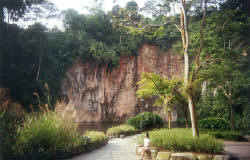 |
| |
Singapore's
granite core is exposed in the face
of this long-abandoned quarry. The outcrop is of lower to mid Triassic age
i.e. around
200 million years old. |
| |
|
The Bukit Batok Nature Park lies on the outskirts of
one of Singapore's newest housing estates, Bukit Batok New Town. It is a
small, peaceful park developed on an abandoned quarry site where the quiet
visitor should be able to see some of the local wildlife which has adapted
to an urban / parkland environment. In the evening the park is popular
with joggers.
Geological Background
Geologically, the core of Singapore comprises a
granite complex, called the Bukit Timah Granite, which was emplaced (i.e.
crystallised from magma underground) in the lower to mid Triassic roughly
200 million years ago. In more central parts of Singapore, including Bukit
Batok and Bukit Timah, this granite was exposed during the last century by
quarrying. Typically, the excavated area in front of a quarry face will
fill up with rainwater. In Bukit Batok this feature has been preserved as
a tranquil lake, providing a home to native wildlife.
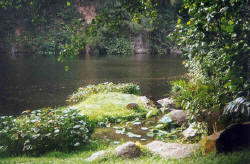 |
|
| The tranquil waters of Bukit
Batok Nature Park - a peaceful oasis in the heart of one of
Singapore's newest housing estates. |
|
| |
|
Park Description
The park covers an area of 36 hectares, at least
half of which is young Secondary Forest. These forested areas have started
to regenerate from former settled areas, where rubber and fruit trees,
such as Jackfruit and Rambutan, once stood. There are a number of forest
paths winding through these areas, some of which lead to vantage points
looking out over the quarry lake. The remainder of the park is planted
with ornamental trees, shrubs, grasses and flowers including various
species of the exotic Heliconia. The path from the main entrance leads
directly to the "Pond Plaza" - a tongue of land extending into the lake
where the visitor can rest awhile.
| |
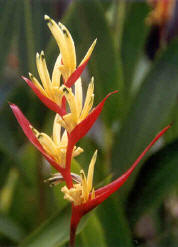 |
| |
The exotic red and yellow
bloom of Heliconia sp. |
| |
|
What To Look Out For
The quarry lake is home to various shy fish species,
however the most obvious inhabitants of the lake are the freshwater
turtles, including the Red-eared Terrapin
Trachemys scripta elegans, an
introduced species common in Singapore's ornamental lakes and ponds easily
identified by the red stripe behind each eye. The
Malayan Box Terrapin
Cuora amboinensis may also be seen; this native species is characterised
by a pair of yellow stripes on each side of its long head and neck.
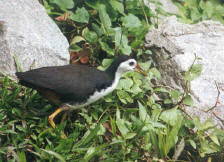 |
|
| A White-breasted Waterhen
Amaurornis phoenicurus patrols the margins of the old quarry lake |
|
| |
|
In the margin of the lake lives the White-breasted
Waterhen Amaurornis phoenicurus, a common species of ornamental ponds.
Bird watchers should also be able to see examples of the brightly coloured
tropical species which have adapted to parkland and urban areas of
Singapore. These include the Black-naped Oriole Oriolus chinensis -
unmistakable in its bright yellow plumage, the Collared Kingfisher
Todirhamphus chloris - identified by its bright blue plumage and white
breast and collar, and high in the trees towards the top of the quarry
face the Blue-tailed Bee Eater Merops philippinus, a common winter
visitor. These species, though common, should be appreciated for their
bright, tropical colours which add a vibrant touch of colour to
Singapore's parks and gardens.
| |
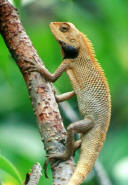 |
| |
A common species, the
Changeable Lizard Calotes versicolor can easily be found in the
park. |
| |
|
In the Secondary Forest keep an eye out for examples
of Singapore's common reptiles including the various gecko species, and
the Changeable Lizard
Calotes versicolor so called because at various
times the lizard may appear brown or green. In the breeding season the
male of the species has a startling bright red throat and orange
shoulders. Less common is the
Green Crested Lizard
Bronchocela
cristatella, a likeable species with a bright green skin and large
inquisitive eyes. This species, once more numerous, appears to have given
way to the Changeable Lizard over the last 20 years.
Squirrels are common too, including the
Plantain
Squirrel Callosciurus notatus, which may be seen feeding on fruiting
trees.
Local History
For those with an interest in World War II history
the park has a memorial plaque identifying the site where Japanese
soldiers built a shrine at the top of Bukit Batok to commemorate their
dead. This is close to the television transmission towers which now
dominate the summit.
Visitor Facilities
The park is ideal for those less mobile or for
families wishing to take their children on a nature walk. Paths are well
made and clearly marked, and there are many park benches and rain
shelters. Drinking fountains have also been installed, and public toilets
are available. There are "fitness stations" where the active can perform
their exercise routines, and there is a small playground for young
children. A spacious car park is also available.
|